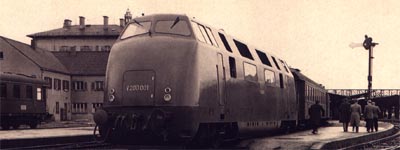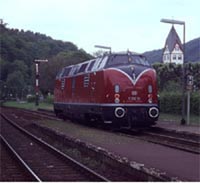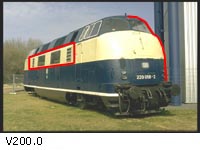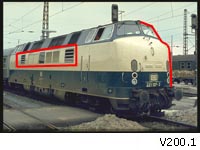| |
V 200
V 200
Construction
In service
V 200
The diesel locomotive program of 1953 (see also epoch III) anticipated also in a two engine diesel locomotive for services in long-distance trains on mainlines with speeds of 140 km/h. Together with Krauss-Maffei, the DB designed the new diesel locomotive. Meanwhile the plans for the new locomotive were changed a litte bit, the locomotive must also be suitable for services in heavy cargo trains. For the construction the engineers looked to the successful diesel locomotive V 80 which was built in 1952. This diesel locomotive was, like almost all DB diesel locomotives equiped with a fast running diesel engine and a hydraulic transmission which drove the axles via a pair of coupled axles.
 | |
In 1953 Krauss-Maffei delivered five prototype locomotives V 200 001-005 to the DB. These locomotives were provided with different engines and transmissions, so that they could try which concept was the best. In the same year the V 200 001 was standing at the traffic exhibition in München. This locomotive was also the first heavy diesel locomotive in the world with a hydraulic transmission. An important testrun was done with the V 200 005. The trip took place between 23 April and 16 May 1955 and was going to the former Yugoslavia, Greece and ended in Turkey. The 10.000 km long trip was done without problems, despite the fact that the capacity of 1470 kW was tight.
Next the DB placed an order for 50 locomotives V 200 with a capacity of 1620 kW. The prototype locomotives were all modified so that these had also a capacity of 1620 kW. Mak in Kiel delivered the V 200 006-025 and Krauss-Maffei delivered the V 200 026-055. All locomotives were entering service between 1956 and 1957.
In 1957 a second order followed, but now only by Krauss-Maffei. In 1959 the locomotives V 200 056-086 were delivered to the DB. The locomotives were unchanged compared with the first order.
 | | Photo: Alex Strueder |
Because of the still rising train weights the need for more powerful variants of the V 200 was also rising. Again the DB ordered by Krauss-Maffei a V 200 locomotive with a capacity of 1986 kW. To carry the higher weights of the diesel engines and to not exceed the maximum weight of 82 ton they made use of light metals and polyester. Also a lighter boiler for the heating installation was installed. To enlarge the cabins, the fronts were more steeper. Because of the accessibility to the engines which were placed under the cabins, the cabins had to enlarged. The diesel engines were the already in the class V 200 used MTU diesel engines, but now with a higher capacity. Between 1962 and 1965 50 locomotives were built and delivered. They got the numbers V 200 101-150.
The V 200 locomotives were the last diesel locomotives of the DB with two diesel engines. From now on only diesel locomotives with one engine were ordered, because this was more efficient.
Construction
After all there are two series of V 200 locomotives built. The V 200.0 and the V 200.1. Both locomotives are distinguished from each other to look to the ventilation grills at the sides. The V 200.0 have at both sides of the central placed numbers two windows from where you can see the engine room. Alongside these windows there are on both sides another windows, which are divided in four smaller swing windows. The V 200.1 has on the place of the two big windows two ventilation grills, and has between both windows, where the V 200.0 has it's numbers a little window from where you can see the engine room. The numbers are standing below this window. The V 200.1 is also distinguished from the V 200.0 by it's fronts. The V 200.1 has a steeper front than the V 200.0. And finally the five prototype locomotives have no ventilation grills just above the red tail lights on both fronts.
 | |
 | |
They used many light metals and polyester to reduce weight. The bogie frames were of steel and were made with two side bars which were welded to the other two sidebars. The axles in the bogies had sheet springs. The V 200.0 had an open bogie construction, the V 200.1 had a closed bogie construction. Also the bogies of the V 200.1 are less heavy than the bogies of the V 200.0.
he locomotive was divided in two cabines, an engine room and two small front rooms. The two engines were standing in the engine room and were working independent from each other. They made use of different 12-cylinder four stroke V engines with turbines. The engines were hung elastically in a three point beared frame.
The prototype locomotives V 200 001-005 were provided with the engines MD 12 V 538 TA from Maybach and the MB 820 Ab from Daimler Benz which was already in use in the V 80. As third engine type the engine L 12 V 17,5/21 from MAN was used in five locomotives built in 1959, and this engine was already used in the locomotives V 80 and the trainsets VT 11 and VT 12. The V 200.1 was driven by engines of type MTU MB 12 V 652 TA each with a capacity of 994 kW, these engines were also used in the V 100.20.
Under the cabins the lighting machines, airpumps and the hydraulic transmissions with built in direction switches were installed. The transmission of the V 200.0 was of type Voith LT 306 r with three hydraulic gears, the other transmission was of type Mekydro K 104 US-SU from Maybach later MTU, with four hydraulic gears. The V 200.1 had an improved transmission from MTU of type Mekydro K 104 U.
The V 200.0 was provided with an oil fired MAN water boiler which was sufficient to heat up 10 or 12 passenger coaches. The V 200.1 had an oil fired boiler of type Vapor-Heating which was much less heavier in weight.
In service
The prototype locomotives V 200 001-005 were stationed at the Bw Frankfurt-Griesheim. From here the locomotives were entering service together with 19 other locomotives in the long-distance services between Bamberg, Hamburg Altona and München. The locomotives pulled for example the F-train F 55/56 Blauer Enzian.
Also the V 200 001 was at the disposal of the BZA München for tests. From 1956, 19 locomotives were stationed at the Bw Hamburg-Altona, they had Frankfurt, Stuttgart and Treuchtlingen as their returning points. Also the Bw's of Hamm and Villingen got V 200 locomotives to maintain. From 1962 V 200.0 locomotives were maintained in Würzburg, and the Bw's of Hannover, Kaiserslautern, Kempten and Limburg got also V 200 locomotives.
In 1968, the locomotives were renumbered to the new UIC numbering scheme. The locomotives V 200.0 became class 220, and the locomotives V 200.1 became class 221.
| Type no: |
V 200.0 |
V 200.1 |
| In service: |
1953 |
1962 |
| Manufacturer: |
Krauss-Maffei, MaK |
Krauss-Maffei |
| Axle layout: |
B'B' |
B'B' |
| Gauge: |
143,5 cm |
143,5 cm |
| Length: |
18,47 m |
18,44 m |
| Weight: |
73,5-81 t |
78 t |
| Traction: |
Diesel-hydraulisch
Dieselmotor:
Aantal: 2
Fabrikant:Maybach (MTU), MAN
Vermogen: 810 kW
(per motor)
(bij 1500 tpm) |
Diesel-hydraulisch
Dieselmotor:
Aantal: 2
Fabrikant:Maybach (MTU)
Vermogen: 993 kW
(per motor)
(bij 1500 tpm)
|
| Torque: |
234,4 kN |
235,4 kN |
| Train heating installation: |
steam |
steam |
| Top speed: |
140 km/h |
140 km/h |
|
